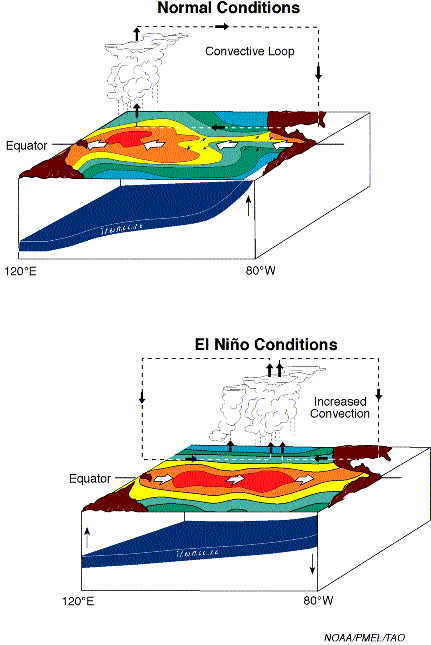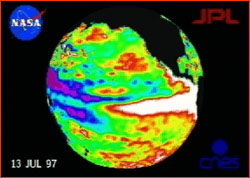
ENSO is the perhaps the most important example of climate variability in the tropics aside from the seasons (though other important ones exist). If the tropics are more predictable than the midlatitudes, and it is believed that they are, long range climate prediction in some regions of the U.S. may rely strongly on our ability to predict the full ENSO cycle (of which La Niña and El Niño are two phases).
ENSO is a type of coupled ocean-atmosphere phenomenon. That is, incremental changes in ocean feedback on the atmosphere which in turn amplify the variations in the ocean. The fact that changes in both the atmosphere and the ocean occur during ENSO and that neither the atmosphere or ocean can by itself be called the "cause" of ENSO has made the subject an intriguing and vast area of research over the past several decades. Many think that our ability to predict ENSO has improved considerably over that time period though some debate does exist regarding just how well we understand it.


Definitions of El Niño, La Niña, and ENSO
El Niño
La Niña
For a more full description of El Niño and La Niña, exmaine the stories as described by the National Oceanic and Atmospherics Administration (NOAA).
The Southern Oscillation Index (SOI), defined as the normalized difference in surface pressure between Tahiti, French Polynesia and Darwin, Australia is a measure of the strength of the trade winds, which have a component of flow from regions of high to low pressure. High SOI (large pressure difference) is associated with stronger than normal trade winds and La Niña conditions, and low SOI (smaller pressure difference) is associated with weaker than normal trade winds and El Niño conditions. The terms ENSO and ENSO cycle are used to describe the full range of variability observed in the Southern Oscillation Index, including both El Niño and La Niña events.
There has been a confusing range of uses for the terms El Niño, La Niña and ENSO by both the scientific community and the general public. Originally, the term El Niño (in reference to the Christ child) denoted a warm southward flowing ocean current that occurred every year around Christmas time off the west coast of Peru and Ecuador. The term was later restricted to unusually strong warmings that disrupted local fish and bird populations every few years. However, as a result of the frequent association of South American coastal temperature anomalies with interannual basin scale equatorial warm events, El Niño has also become synonymous with larger scale, climatically significant, warm events. There is not, however, unanimity in the use of the term El Niño. The tendency in the scientific community though is to refer interchangeably to El Niño, ENSO warm event, or the warm phase of ENSO as those times of warm eastern and central equatorial Pacific SST anomalies. Conversely, the terms La Niña, ENSO cold event, or cold phase of ENSO are used interchangeably to describe those times of cold eastern and central equatorial Pacific SST anomalies.
The terms "El Viejo" and "anti-El Niño" have also been applied
to the cold phase of ENSO. However, these terms are used less frequently,
as the term La Niña has gained currency.